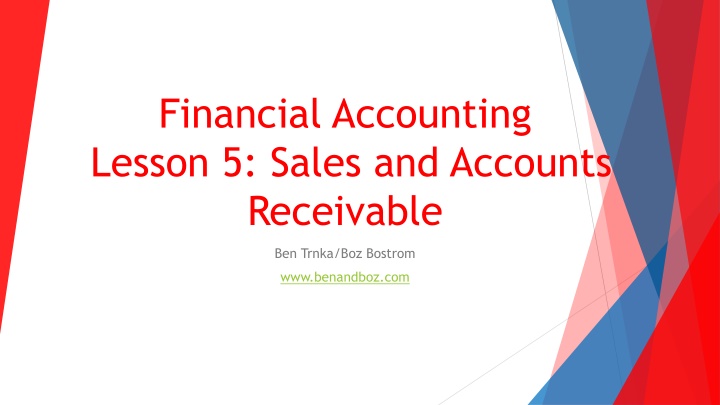
Sales and Accounts Receivable in Financial Accounting
Dive deep into sales processes, accounts receivable management, and revenue recognition principles in financial accounting. Explore topics like credit cards, returns, allowances, and more to enhance your understanding of sales transactions and accounts receivable handling.
Download Presentation

Please find below an Image/Link to download the presentation.
The content on the website is provided AS IS for your information and personal use only. It may not be sold, licensed, or shared on other websites without obtaining consent from the author. If you encounter any issues during the download, it is possible that the publisher has removed the file from their server.
You are allowed to download the files provided on this website for personal or commercial use, subject to the condition that they are used lawfully. All files are the property of their respective owners.
The content on the website is provided AS IS for your information and personal use only. It may not be sold, licensed, or shared on other websites without obtaining consent from the author.
E N D
Presentation Transcript
Financial Accounting Lesson 5: Sales and Accounts Receivable Ben Trnka/Boz Bostrom www.benandboz.com
Overview Understand Sales at a new level of depth Credit Cards Returns and Allowances Discounts Understand Accounts Receivable at a new level of depth Bad Debt Expense and the Allowance for Doubtful Accounts Percentage of Credit Sales and A/R Aging Method
Sales When is a sale recorded? General rule is that revenue is recorded when goods are delivered or services are provided Goods in transit - two key terms used in the business world: FOB Shipping Record a sale when the goods have been shipped FOB Destination Record a sale when the goods reach their destination Who cares about the difference? Timing of revenue Consider shipments via boat which are on the ocean over a year-end Liability if goods damaged/lost in transit More guidance on revenue recognition is available and can be quite complicated, focused on in intermediate accounting courses
Sales Credit Cards Why? By accepting credit cards, companies open themselves up for more business Businesses receive cash from the credit card companies, so they do not assume credit risk for individual customers Businesses do have to pay a fee to the credit card company, which reduces net sales revenue What happens from the company standpoint? When a customer pays with a credit card: Dr. Cash Dr. Credit Card Discounts (contra-revenue) Cr. Sales
Sales Credit Cards Example Initial Purchase Entry James purchases $100 worth of supplies from CVS using a credit card. The card charges CVS a 3% fee for each transaction. The supplies cost CVS $50. Net Sales: Sales: Less Credit Card Discounts: $3 Net Sales: $100 Cash $97 $3 $97 Credit Card Discounts Sales $100 COGS $50 Inventory $50
Sales Returns and Allowances Why? Sometimes customers return goods that aren t needed More common in certain industries, such as retail, hardware, and auto parts What happens from the selling company s standpoint? When goods are returned: Dr. Sales Returns and Allowances (contra-revenue) Cr. Accounts receivable (or cash) Dr. Inventory Cr. COGS
Sales Returns and Allowances Example Initial Purchase Entry James purchases $100 worth of supplies on account from CVS. The supplies cost CVS $50. Return Entry James realizes he won t use $100 worth of supplies, so he returns $70 worth of the supplies. Accounts Receivable $100 Sales Returns and Allowances $70 Sales $100 Accounts Receivable $70 COGS $50 Inventory $35 Inventory $50 COGS $35 Net Sales: Sales: Less Returns and Allowances: $70 Net Sales: $100 $30
Sales Discounts Why? Provide discounts to entice customers to purchase more Provide an incentive for customers to pay more quickly, which reduces the risk of customers not paying at all In some business to business transactions, companies offer discounts. An example is 2/10, n/30 A 2% discount is provided if payment is made within 10 days, otherwise full payment is due within 30 days What happens from the company standpoint? When a customer takes advantage of a discount: Dr. Sales Discounts (contra-revenue) Dr. Cash Sales
Sales Discounts Example Initial Purchase Entry James purchases $100 worth of supplies on account from CVS with terms 2/10, n/30. The supplies cost CVS $50. Discount Entry James decides to take advantage of the discount and pays on day 9. Cash $98 $2 Sales Discounts Accounts Receivable $100 $50 Accounts Receivable $100 Sales $100 COGS Net Sales: Sales: Less Discounts: Net Sales: Inventory $50 $100 $2 $98
Accounts Receivable and the Allowance for Doubtful Accounts Do all customers always pay their debts? Unfortunately NO! Using the Direct Method, a company would make the following entry when writing off an account Dr Bad Debt Expense Cr Accounts Receivable However, this write-off often appears in a year after the sale was made, so expense is not matched to revenue Thus, this method is generally not used
Accounts Receivable and the Allowance for Doubtful Accounts Indirect Method - Companies must reserve part of Accounts Receivable based on an estimate of how much will not be collected Two New Accounts Allowance for Doubtful Accounts Bad Debt Expense
Indirect Method - Example Example - a company has $100 of Accounts Receivable, and estimates that $10 will not be collected. What is the journal entry? Bad Debt Expense $10 Allowance for Doubtful Accounts $10 What is the impact to Accounts Receivable on the financial statements? Gross Accounts Receivable: $100 Less Allowance for Doubtful Accounts: ($10) Net Accounts Receivable: $90 What happens when the company writes off the $10? Allowance for Doubtful Accounts $10 Accounts Receivable $10
Estimating the Allowance for Doubtful Accounts In the previous example, where did the $10 come from? Each business needs to estimate the amount of Accounts Receivable that won t be collected Two Methods to Estimate Percentage of Credit Sales Aging of A/R
Percentage of Credit Sales Method Goal: Estimate the amount of Bad Debt Expense related to the current period s sales Start with Credit Sales and multiply by a given percentage Often a historical average Example: Credit sales for the period were $1,000, and historically 2% of credit sales were uncollectible. What is the amount and entry for Bad Debt Expense? $1,000 * 2% = $20 Bad Debt Expense $20 Allowance for Doubtful Accounts $20
Aging of Accounts Receivable Method 4 Step Process Goal: Estimate the amount of Accounts Receivable which will not be collected Break total Accounts Receivable into different buckets based on the age of the receivable 1. Example: Current, 1-30 days past due, 31-60 days past due, etc. Assign an uncollectible percentage to each bucket 2. Example: Current is 1%, 1-30 days past due is 5%, 31-60 days past due is 8%, etc. Multiply the balance in each bucket by the percentage, and add the amounts together to determine the desired ending Allowance for Doubtful Accounts balance 3. Make a journal entry to adjust the Allowance for Doubtful Accounts to the desired ending balance 4.
Aging of Accounts Receivable Method Step 1 A company has an Accounts Receivable balance of $1,000. We need to break out this amount into different buckets based on the age of each individual receivable Accounts Receivable Aging Schedule 31-60 Days Past Due 100.00 $ 61-90 Days Past Due 40.00 $ 1-30 Days Past Due 150.00 $ 91+ Days Past Due 10.00 $ Bucket: Current 700.00 $ Total 1,000.00 $ Amount
Aging of Accounts Receivable Method Step 2 Now that we have Accounts Receivable divided into buckets, we can assign an uncollectible percentage to each bucket Accounts Receivable Aging Schedule 31-60 Days Past Due 100.00 $ 61-90 Days Past Due 40.00 $ 1-30 Days Past Due 150.00 $ 91+ Days Past Due 10.00 $ Bucket: Current 700.00 $ Total 1,000.00 $ Amount Uncollectible Percentage: 1% 5% 8% 10% 20%
Aging of Accounts Receivable Method Step 3 Multiple each bucket by the uncollectible percentage and sum to determine the total uncollectible amount Accounts Receivable Aging Schedule 31-60 Days Past Due 100.00 $ 61-90 Days Past Due 40.00 $ 1-30 Days Past Due 150.00 $ 91+ Days Past Due 10.00 $ Bucket: Current 700.00 $ Total 1,000.00 $ Amount Uncollectible Percentage: Uncollectible Amount: 1% 5% 8% 10% 4.00 20% 2.00 $ 7.00 $ 7.50 $ 8.00 $ $ $ 28.50
Aging of Accounts Receivable Method Step 4 Adjust the Allowance for Doubtful Accounts so the ending balance is $28.50. Assume that the balance in the account prior to this adjusting entry is $20 Balance before adjustment $20.00 Adjustment needed $8.50 $28.50 Desired Ending Balance Bad Debt Expense $8.50 Allowance for Doubtful Accounts $8.50
Key Takeaways Companies often track returns and discounts using contra-revenue accounts Tracking also helps with analysis of business operations Companies must also make an estimate each period to recognize that not all customers are going to pay Use the Allowance for Doubtful Accounts and Bad Debt Expense Estimate using the Percentage of Credit Sales method or the Aging of Accounts Receivable method Thanks for tuning in!






















